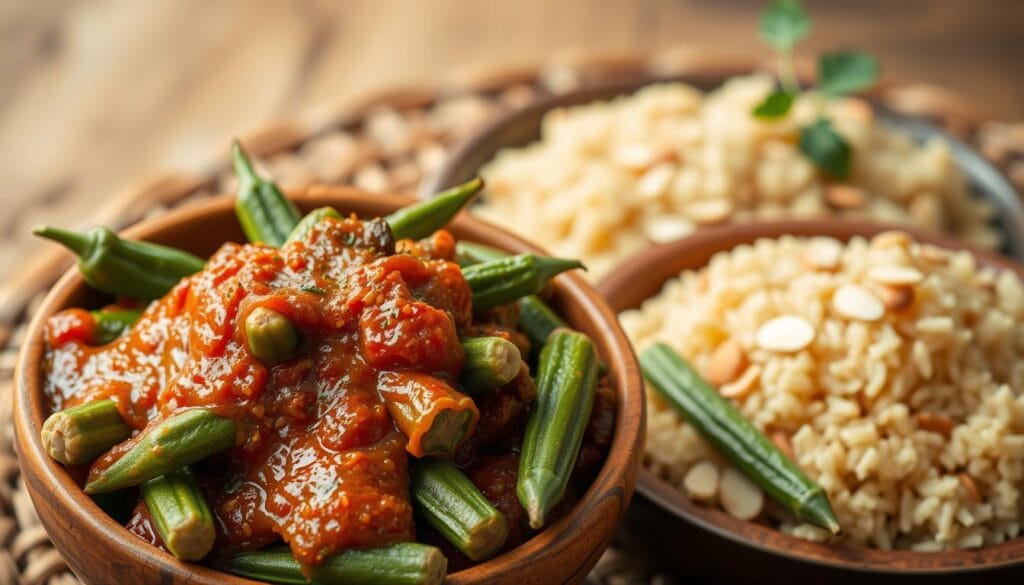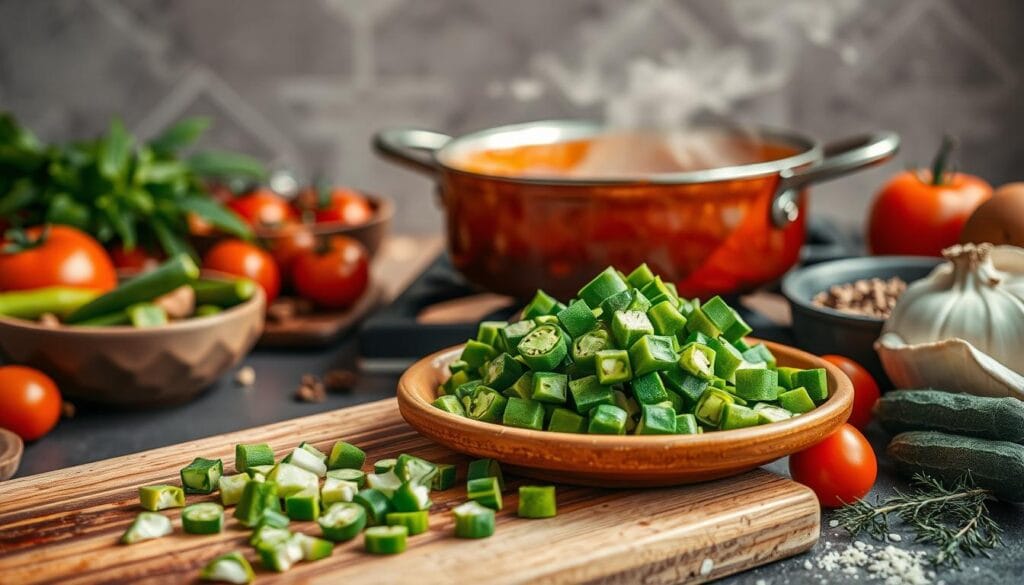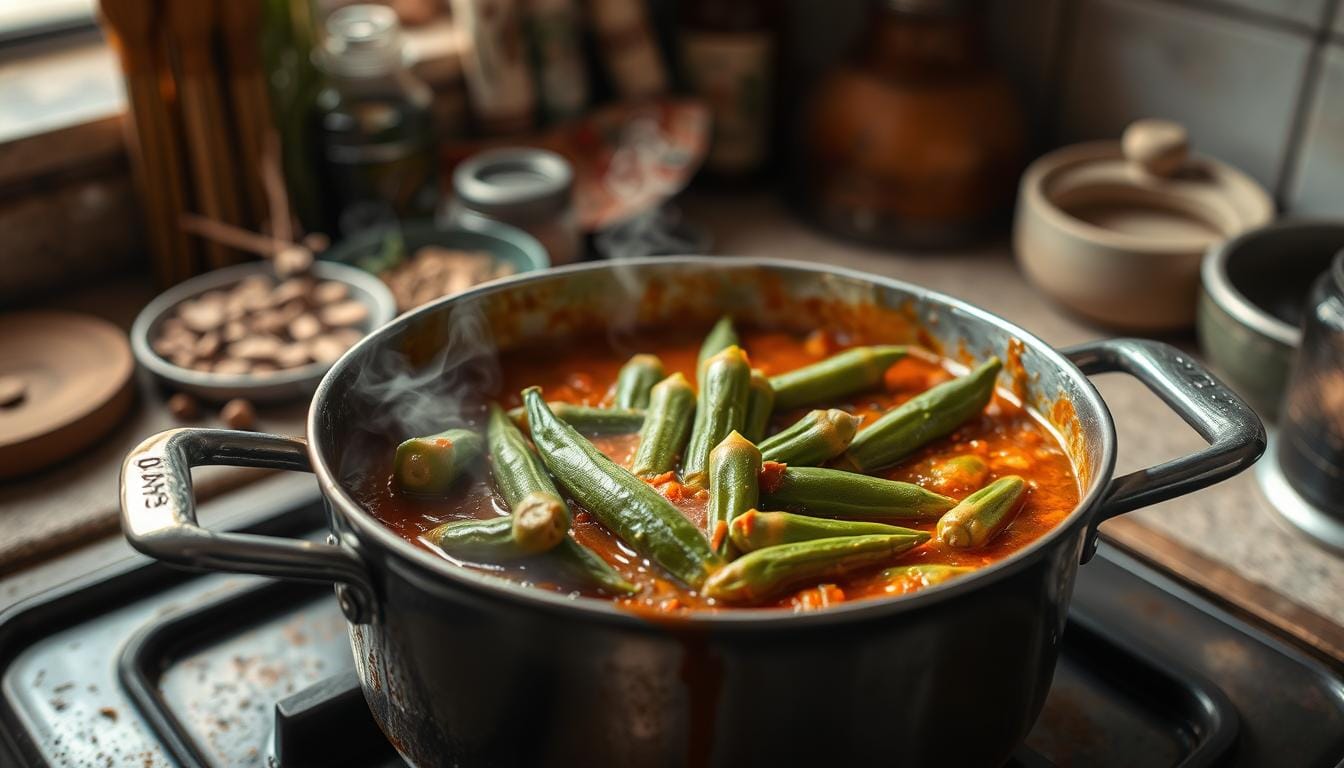Egyptian Bamia has been with me in every kitchen I’ve been in. It’s more than just a meal; it’s a warm hug in a bowl. It’s a tradition that connects us to our ancestors.
Learning to make this stew was more than just following a recipe. It was tasting the heart of Egyptian cuisine. Every spoonful is filled with stories of family and love.
This journey is about more than cooking. It’s about how Egyptian Bamia brings people together. Let’s explore its secrets, one spice at a time.
What is Egyptian Bamia?
Let’s dive into what makes Egyptian Bamia unique. It’s a dish that celebrates tradition, made with ingredients that share stories of Egyptian kitchens. At its core, it features Popular Egyptian vegetables like okra, which turns into a smooth base when cooked. Garlic, tomatoes, and spices like cumin and coriander blend together, offering a taste that warms the heart.
Understanding the Ingredients
Each part of Egyptian Bamia contributes to its charm. Here’s what you’ll find:
- Okra (Bamia): The main attraction, known for its special texture and health benefits.
- Tomatoes: They form the sauce’s base, often fresh or blended for extra flavor.
- Spices: A touch of salt, a sprinkle of garlic, and spices like cinnamon or red pepper.
- Protein: Chicken or beef adds substance, but vegetarian options are also popular.
Cultural Significance
In Egypt, Egyptian Bamia is more than food—it’s a memory. It’s the aroma of cooking in busy markets and the first dish many learn to make. Families come together, sharing stories as they enjoy their meal. As a Cairo chef once said,
“Bamia is the glue that holds our tables—and hearts—together.”
It’s enjoyed at weddings, Ramadan iftars, and cozy nights at home. This shows that comfort food has no limits.
Want to bring this warmth into your kitchen? Halal-friendly recipes and tips are waiting to welcome you.
The Unique Flavor Profile of Bamia
Let me take you on a journey into the heart of Bamya recipe. Each spoonful is a story of warmth and tradition. Imagine the okra’s soft texture, wrapped in spices that hug your taste buds.
Spices and Seasonings
This dish is all about a special blend. Cumin brings a deep earthy flavor. Coriander adds a citrusy touch. Smoked paprika gives a smoky hint, and garlic ties it all together.
Some families add cinnamon for a sweet yet subtle twist. It’s both bold and comforting.
- Cumin: Earthy warmth that anchors the dish
- Coriander: Bright, herbal freshness
- Smoked paprika: Adds a hint of smoky complexity
Popular Cooking Techniques
In Middle Eastern cooking, patience is key. Here’s how to master it:
- Simmer gently: Let the pot bubble softly for 45 minutes—this is where flavors marry and deepen.
- Oil first, then onions: Sauté them until translucent to build a savory base.
- Adjust heat: Some traditions cook covered to lock in moisture, while others leave the lid off for a thicker sauce—your choice!
Every step here is a bridge to your heritage or a new adventure. Let these techniques guide you toward a dish that feels like coming home.
How to Prepare Authentic Egyptian Bamia
Start your journey to making Okra stew with love and patience. Every step is a chance to improve your cooking skills gently.
Essential Kitchen Tools
A few simple tools make a big difference. Here’s what you’ll need:
- A heavy pot with a lid (like a Dutch oven) to cradle your stew
- A sharp knife and cutting board
- A wooden spoon for gentle stirring
- A colander for rinsing ingredients
Step-by-Step Cooking Guide
Follow these steps like a recipe for comfort:
- Prepare the okra: Rinse pods and pat dry. Trim stems without cutting the pods to avoid sogginess.
- Sauté aromatics: Heat oil in your pot, then sauté onions and garlic until soft—this builds the dish’s foundation.
- Add okra: Layer okra in the pot, ensuring each piece is bathed in the onion-garlic base.
- Simmer with care: Add tomatoes, spices, and water. Let it cook on low heat for 30–40 minutes, stirring occasionally.
- Finish with love: Taste and adjust seasoning. Serve warm with bread or rice.
“Patience is your best ingredient—let the flavors marry slowly, like a slow dance.”
Remember: Okra stew thrives when cooked with kindness. Trust each step, and you’ll savor the warmth of tradition in every bite.
Traditional Recipes Featuring Bamia
Every spoonful of Bamya recipe tells a story. In Egyptian kitchens, these dishes are more than meals—they’re heirlooms passed from grandmother to grandchild. Let me share how these Authentic Egyptian dishes become a bridge between generations.

Classic Egyptian Bamia Stew
Imagine a pot simmering with tender okra, slow-cooked lamb, and a medley of warm spices. This Bamya recipe is a hug in a bowl. Serve it with crusty bread to soak up the velvety sauce, just like my abuela taught me. Here’s what makes it unforgettable:
- Rich tomato base
- Spice blend of cinnamon and cumin
- Simmered until the okra melts into the broth
Vegetarian Bamia Dishes
“The okra’s heartiness needs no meat to shine,” my aunt once said. “Let its natural sweetness dance with the spices.”
Vegetarian versions celebrate okra’s earthy depth. Try it with roasted eggplant or chickpeas—these dishes aren’t substitutions; they’re a celebration of plant-based joy. Here’s how to elevate them:
- Use fresh okra for crisp-tender texture
- Pair with tahini drizzle for creaminess
- Sprinkle with parsley for freshness
These recipes carry the soul of Cairo’s markets into your kitchen. Whether meaty or meatless, they’re proof that tradition and innovation can coexist in one pot.
Nutritional Benefits of Bamia
Okra stew is more than just tasty—it’s packed with health benefits. As a favorite among popular Egyptian vegetables, bamia is both comforting and nutritious. It offers a daily boost to your health.
Vitamins and Minerals
Bamia is full of nutrients your body needs. It has vitamin C to protect your immune system, folate for cell growth, and potassium for heart health. Each spoonful also brings magnesium for muscle relaxation and antioxidants to fight stress.
Studies suggest it might help with diabetes, but more research is needed1.
- Vitamin C: Strengthens immunity
- Folate: Supports cell growth
- Potassium: Balances heart and nerve health
Dietary Fiber Highlights
The soluble fiber in bamia helps your digestion. It makes digestion easier and may help control blood sugar. It’s like a gentle hug for your body from the inside.
When you enjoy this dish, remember it’s more than food. It’s a promise of nourishment for your body. Bamia gives you both comfort and care.
1Learn more about okra’s potential here.
Pairing Bamia with Other Dishes
Imagine sitting at a table where every dish sings in harmony—a hallmark of Traditional Egyptian cuisine. Let’s craft a meal that feels like a warm embrace. Bamia takes center stage alongside sides and drinks that balance its rich flavors.
Complementary Sides
We love how simple dishes elevate Bamia’s boldness. Try these time-honored combinations:
- Fluffy basmati rice to soak up the tangy sauce
- Warm baladi bread for dipping into the stew
- A crisp lettuce or cucumber salad to refresh the palate
Beverage Suggestions
Inspired by Middle Eastern cooking traditions, here’s what pairs perfectly:
| Beverage | Description |
|---|---|
| Karkade (hibiscus tea) | Crystalline ruby-red tea with a tart, cooling finish |
| Mint lemonade | Fresh citrusy sipper with bright herb notes |
| Arabic coffee | Strong, cardamom-spiced brew for post-meal warmth |
“Every element in a meal should converse—not compete,” says a recipe guide from our community. This wisdom shapes how we build tables that nourish both body and soul.
Think of each component as a friend at your table—supportive yet distinct. Whether you’re serving a family gathering or a cozy dinner for two, these pairings honor centuries of culinary wisdom. The goal is to create a meal that feels like coming home.
Where to Find Quality Bamia
Choosing the right ingredients is key to making Authentic Egyptian dishes, especially Egyptian Bamia. Let’s find the best okra and spices for your kitchen. This way, you can connect with tradition.
“A good vendor knows their okra like family—ask them when it was harvested and how to spot tender pods.”
Local Markets in the U.S.
- Look for Middle Eastern grocery stores in cities like Chicago, Houston, or Los Angeles. They usually have fresh or frozen okra all year.
- Go to summer farmers’ markets for local okra. Ask the growers about the best varieties for thick stews.
- Get to know the vendors. Tell them you want to make Egyptian Bamia. They’ll help you find the best ingredients.
Online Shopping Options
- Buy dried okra or spice blends from trusted sites like Kalustyan’s or Penzeys. They offer Egyptian Bamia authenticity.
- Amazon has pre-measured spice kits that go great with imported okra.
- Check international grocers like Fairway Market’s online for hard-to-find ingredients.
Every ingredient has a story. Whether you’re in a market or online, quality comes from curiosity and connection. Your journey to Authentic Egyptian dishes starts here. I’m here to help every step of the way.
Tips for Cooking Bamia Like a Pro
Make your kitchen a cozy learning space. Every mistake is a lesson, and every success is a triumph. Here’s how to master this beloved dish with ease.

Common Mistakes to Avoid
One hurdle newcomers face is the slimy texture in how to cook Bamia. This happens when okra’s natural mucilage overflows. Here’s how to outsmart it:
- Handle okra gently—don’t overcut or bruise it before cooking.
- Pat okra dry before sautéing; moisture accelerates slime.
- Resist adding salt too early—salt draws juices out, so wait until later in the recipe.
Expert Tricks for Perfect Texture
My grandmother taught me that a dash of acid works wonders. A squeeze of lemon or a splash of vinegar during cooking balances the texture beautifully. For Vegan Egyptian recipes, try these secrets:
- Toast okra in a dry pan for 2-3 minutes before adding liquid—this seals in flavor and texture.
- Use a heavy pot to retain heat evenly, ensuring the dish simmers steadily.
- Pair with tangy yogurt or a squeeze of lime at serving time to enhance balance.
Every time you experiment, you’re not just cooking—you’re weaving your own story into this ancient tradition. Slip-ups? They’re just part of the journey. Your kitchen is a safe place to grow, so take your time and savor the process.
Experimenting with Bamia in Modern Cuisine
Every recipe can grow while keeping its roots. Let’s see how bamia can move beyond its traditional form. It can explore new tastes while keeping its cultural essence. Here’s how to mix new ideas with respect for this classic dish.
Fusion Recipes to Try
Think of bamia as a blank canvas for global flavors. For Vegan Egyptian recipes, add silken tofu to the stew. Simmer it with turmeric and cumin to make a protein-rich base for grain bowls or stuffed peppers. Or mix the tangy okra with Italian pasta, using Middle Eastern spices like sumac to brighten a creamy sauce. These changes are not just new; they’re conversations between old and new.
Creative Serving Suggestions
Use presentation to tell a story. Serve in small clay pots for a rustic feel, or in crispy phyllo cups for a modern twist. For Middle Eastern cooking lovers, top with pickled onions or garlic yogurt for crunch and zest. Even a sprinkle of pomegranate seeds can make a dish pop with color and contrast.
Whether you’re making a vegan version or mixing cuisines, remember: every change respects bamia’s heritage. Your kitchen is a place to innovate with respect—where tradition meets creativity. Share your dishes, and let bamia’s story unfold through your cooking.
FAQ
What is Egyptian Bamia?
Egyptian Bamia, also known as okra, is a favorite in Traditional Egyptian cuisine. It’s tender and has a unique taste. The dish combines okra with tomatoes, garlic, and spices for a cozy meal.
Is Bamia suitable for vegan diets?
Yes! Bamia is great for vegan recipes. You can make it in stews without meat and still enjoy its rich flavors.
What are some common side dishes to serve with Bamia?
Serve Bamia with fluffy white rice to soak up the sauce. Warm Egyptian bread is also great for scooping. A cucumber and mint salad adds a refreshing touch.
How can I adjust the spice levels in my Bamia?
Adjusting spice levels is up to you. Start with mild spices and add more pepper or cayenne for heat. This way, everyone can enjoy the dish.
What should I look for when choosing okra?
Choose tender, bright green okra pods without blemishes. Smaller pods are more tender. Fresh okra is best for flavor and texture.
Can I make Bamia ahead of time?
Yes, Bamia is great for making ahead! It tastes better after sitting. Refrigerate it in an airtight container and reheat gently when ready.
Are there any creative ways to serve Bamia?
Definitely! Serve Bamia in earthenware dishes for a unique look. Or, use it as a filling in savory hand pies for a modern twist.
What is the nutritional value of okra?
Okra is not just tasty but also nutritious! It’s full of vitamin C, folate, and fiber. Adding Bamia to your meals is good for your health.
Where can I find quality okra in the U.S.?
Find fresh or frozen okra at Middle Eastern or international markets. Farmer’s markets are also good in summer. Online retailers offer dried okra and spices too.
We are interested in your feedback
There are no reviews yet. Be the first one to write one.

